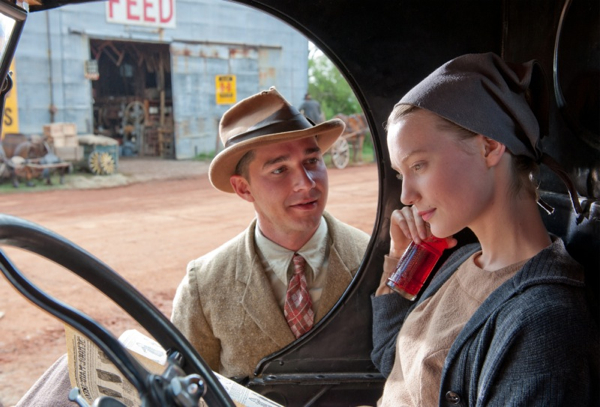Movie review by Greg Carlson
A violent, pulpy, Prohibition-era slugfest, “Lawless” adapts Matt Bondurant’s historical novel “The Wettest County in the World,” a yarn based on the adventures of the author’s bootlegger grandfather and two great uncles. Loosely interpreting the events of the so-called Great Franklin County Moonshine Conspiracy, the Virginia-set melodrama capitalizes on the sacred tropes of the gangster genre without matching the transcendence or grandeur of top-shelf examples like “Bonnie and Clyde,” “The Godfather” and “Miller’s Crossing.” Showcasing the talents of an impressive roster of past, present, and future award contenders, “Lawless” pins its hopes primarily on narrator and youngest Bondurant Shia LaBeouf – a risky strategy when Tom Hardy and Jessica Chastain are around.
“Lawless” reunites director John Hillcoat with several key members of the filmmaking team that produced “The Proposition,” including screenwriter and composer Nick Cave, composer Warren Ellis, cinematographer Benoit Delhomme, and actors Guy Pearce and Noah Taylor. Fans of that terrific 2005 film will notice many thematic and stylistic similarities between the Austrialian Western and “Lawless,” the most pronounced of which is a grim fascination with brutal, even gruesome mayhem. Both films also deal with the family ties of trios of brothers bound by blood but threatened by impulsiveness.
Screenwriter Nick Cave’s treatment of Old Testament themes admirably strives to weave streaks of black humor and period color with the high-stakes warfare that erupts when the Bondurants refuse to roll over for the outsider lawmen who want too fat a cut of their lucrative moonshine operation. A great deal of care is taken in the visual and sound design of altercations in which brass knuckles crack and slit throats gurgle. If he’s not meting out spectacular punishment, Hardy’s Forrest Bondurant is tough enough to withstand any physical threat cooked up by Special Agent Charlie Rakes, Pearce’s fussy, lethal dandy. The two actors are a study in opposites, although both turns are mannered. Pearce vamps as the twisty, vain, sadist while Hardy relies on grunts.
The two principal female characters in “Lawless” fare largely as expected in a universe , defined by the savagery of gunslingers. Both Jessica Chastain and Mia Wasikowska do the most with the least, in spite of their function as romantic partners for men whose interests drive the action. Chastain, following up a year of performances that brought seemingly instant stardom and critical acclaim, embraces her abused showgirl-with-a-heart-of-gold to share an erotic charge previously hidden. Wasikowska, whose apparent off-screen indifference to the antics of LaBeouf inspired her co-star to spin publicity around his drunken behavior, has the task of making us believe her serious-minded preacher’s daughter would buy what LaBeouf’s callow braggart is peddling.
The most significant deficit of “Lawless” emerges via the narrative’s multiple, fractured arcs. Juggling its large cast of key players, the focus on LaBeouf’s untested, wide-eyed striver gobbles up attention that might be more satisfyingly focused on the relationship between Hardy’s Forrest and Chastain’s Maggie, which unfolds at the diner the Bondurant’s use as home base (an intriguing and underutilized setting). Other fascinating characters populate the margins, including Gary Oldman’s colorful big city machine gunner Floyd Banner, but his cameo, dispatched with the villainous verve of several of the actor’s vintage turns, leaves the viewer wanting a great deal more than the filmmakers can offer.
